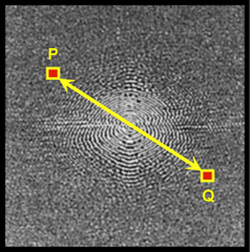|
This amazing result derives from the fact that some of the information in k-space is redundant. Provided no phase errors occur during data collection, k-space possesses a peculiar mirrored property known as conjugate (or Hermitian) symmetry.
Conjugate symmetry applies to pairs of points (like P and Q) that are located diagonally from each other across the origin of k-space. If the data at P is the complex number [a+bi], the data at Q is immediately known to be P's complex conjugate, [a−bi].
|
Advanced Discussion (show/hide)»
A current popular method used for partial Fourier estimation is known as homodyne reconstruction. This technique involves sequential application of a two filters to the acquired k-space data. The first (a high-pass filter) doubles the amplitude of this data and then discards the imaginary part of the image after the Fourier transform. The second (low-pass) Homodyne filter creates a "correction image" from a small set of data acquired symmetrically around the center of k-space. The phase of this "correction image" is subtracted from the phase of the first (high-pass) filtered image image before discarding the imaginary part of the image.
In echo-planar imaging (EPI) echoes acquired late after the RF-excitation pulse will have different phase than those occurring early. This is a source of additional phase errors and makes phase estimation more difficult. For EPI often 6/8 to 7/8 of k-space must be sampled in partial Fourier techniques to accurately estimate the remaining portion.
Feinberg DA, Hale JD, Watts JC et al. Halving MR imaging time by conjugation: demonstration at 3.5 kG. Radiology 1986; 161:527-531.
MacFall JR, Pelc NJ, Vavrek RM. Correction of spatially dependent phase shifts for partial Fourier imaging. Magn Reson Imaging 1988; 6:143-145.
McGibney G, Smith MR, Nichols ST, Crawley A. Quantitative evaluation of several partial Fourier reconstruction algorithms used in MRI. Magn Reson Med 1993;30:51-59
Williams LR. Symmetry. Lecture Notes for Computer Science 530, University of New Mexico, 2011. Available at http://www.cs.unm.edu/~williams/cs530/symmetry.pdf
How does phase-conjugate symmetry work? Why is it used?
What is read conjugate symmetry (fractional echo) imaging? Why would one only want to sample part of an echo?


